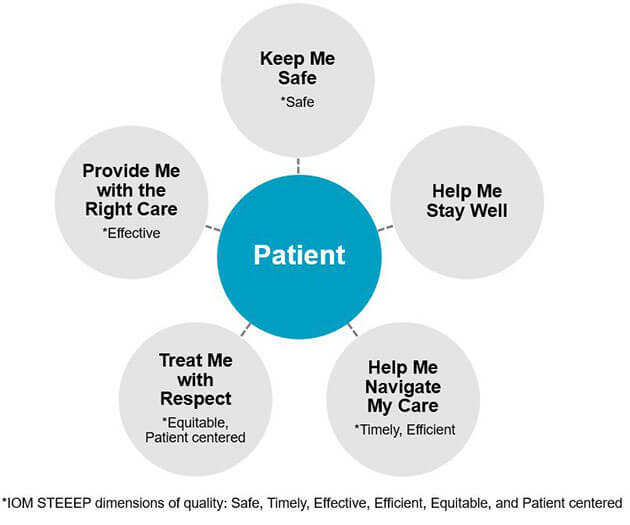Why It Matters
The following is an excerpt from the IHI Framework for Effective Board Governance of Health System Quality white paper.
Achieving better quality care in health systems requires a complex and multifaceted partnership among health care providers, payers, patients, and caregivers. The IHI Lucian Leape Institute’s research scan, evaluation of governance education in quality, and expert interviews made it clear that board members, and those who support them, desire a clear and consistent framework to guide core quality knowledge, expectations, and activities to better govern quality. To help make progress in this area, the IHI Lucian Leape Institute convened leading governance organizations, health industry thought leaders, and trustees to collaboratively develop a new comprehensive framework and assessment tool for governance of quality.
The framework and assessment tool are designed with the following considerations:
- Simplify concepts: Use simple, trustee-friendly language that defines actionable processes and activities for trustees and those who support them to oversee quality.
- Incorporate all six STEEEP dimensions of quality: Understand quality as care that is safe, timely, effective, efficient, equitable, and patient centered (STEEEP), as defined by the Institute of Medicine.
- Include community health and value: Ensure that population health and health care value are critical elements of quality oversight.
- Govern quality in and out of the hospital setting: Advance quality governance throughout the health system, not solely in the hospital setting.
- Advance organizational improvement knowledge: Support trustees in understanding the ways to evaluate, prioritize, and improve performance on dimensions of quality.
- Identify the key attributes of a governance culture of quality: Describe the elements of a board culture and commitment to high-quality, patient-centered, equitable care.
IHI worked with the expert group to establish an aspirational vision for trustees: With the ideal education in and knowledge of quality concepts, every trustee will be able to respond to three statements in the affirmative (see Figure 1).

Figure 1. Vision of Effective Board Governance of Health System Quality
Having established the vision, the expert group proceeded to define the core knowledge and core processes necessary to realize this vision, resulting in the development of a Framework for Governance of Health System Quality (see Figure 2).

Figure 2. Framework for Governance of Health System Quality
At the heart of the framework [CENTER] is the Governance of Quality Assessment (GQA), which outlines the key processes and activities that, if well performed, enable trustees to achieve the vision of effective board governance of quality [RIGHT]. The GQA serves as both a roadmap of the key processes the board should undertake to oversee all dimensions of quality, and an assessment of how well the board is doing with respect to those processes.
The expert group also identified three core knowledge areas [LEFT] that support the effective execution of the core processes and activities outlined in the GQA: Core Quality Knowledge, Core Improvement System Knowledge, and Board Culture and Commitment to Quality. The expert group’s suggestions for core knowledge are assembled into three support guides (available in Appendix A of the white paper).
Together, the GQA and the three support guides aim to reduce variation in current governance recommendations and practices and to establish a comprehensive framework for the core knowledge and key activities for fiduciary governance of quality. Health system leadership and governance educators can use these tools to calibrate and advance their educational materials for trustees and develop ongoing education.
Patient-Centered Depiction of Quality
The expert group supported the use of a patient-centered framework, like the one introduced at Nationwide Children’s Hospital in Ohio,20 to display the core components of quality and drive home the direct impact they have on care. There is a compelling case for conveying this information to the board using a patient lens, as trustees may find the patient perspective on quality more motivating and actionable than the STEEEP terminology.
This reframed model also bundles some elements of STEEEP together in a way that represents the patient journey and avoids some of the health care terminology that can be off-putting to trustees. For example, the STEEEP dimensions of timely and efficient care are combined into “Help Me Navigate My Care.” The STEEEP dimensions of equitable and patient-centered care are aggregated into “Treat Me with Respect.” Figure 3 presents a visual representation of the core components of quality from the patient’s perspective, with the patient at the center of the delivery system.

Figure 3. Core Components of Quality from the Patient’s Perspective
The new framework and assessment tool will reveal areas for quality improvement to many CEOs and board members. It will take time for board members and health system leaders to incorporate those additional elements of quality into their agendas and work plans, but the changes will help to better align their quality oversight with patient expectations and the evolution, expansion, and complexity of health care delivery. Maintaining the status quo with regard to quality governance will not best serve patients or health systems, which face increasing complexity of patient-, population-, and community-based care in the coming years.
Editor’s note: To learn more about the IHI framework to help health care boards and leaders effectively oversee quality and for additional resources, read the IHI Framework for Effective Board Governance of Health System Quality white paper.
You may also be interested in:
